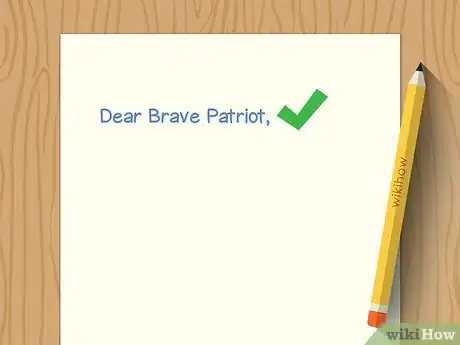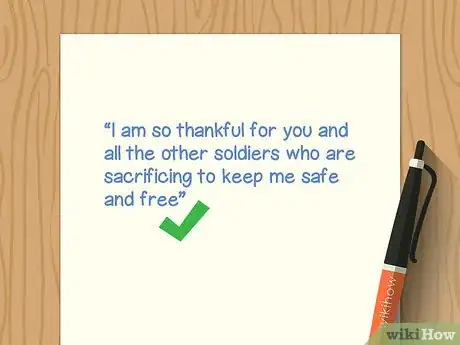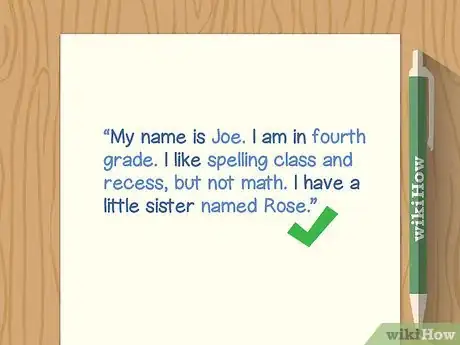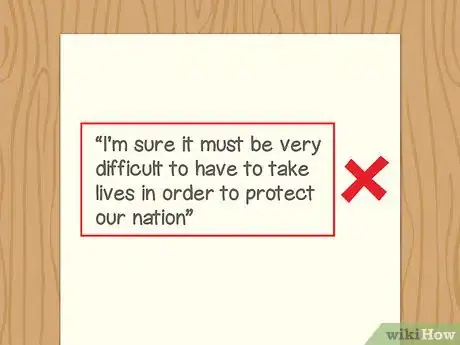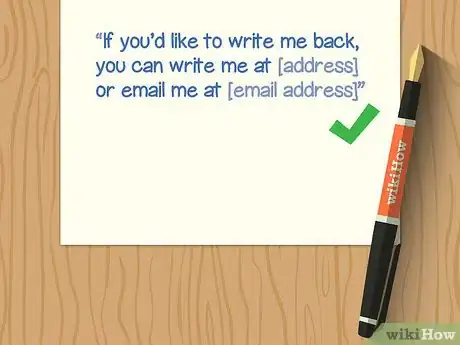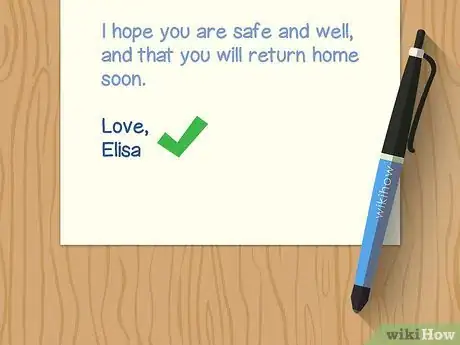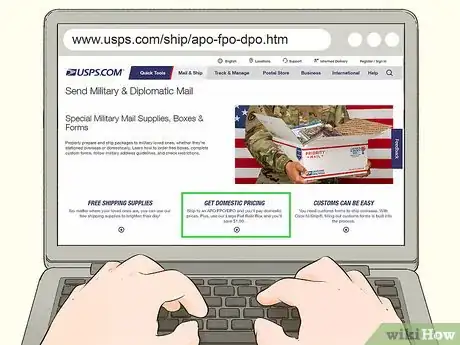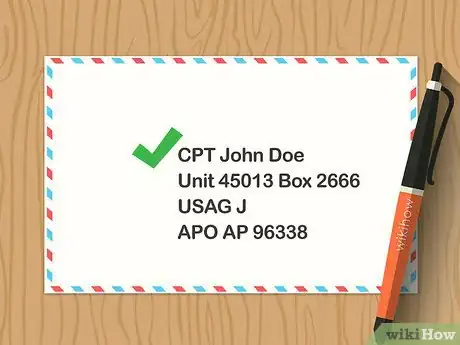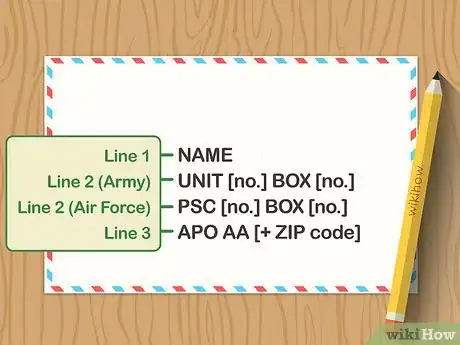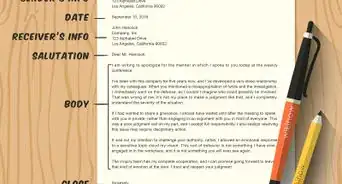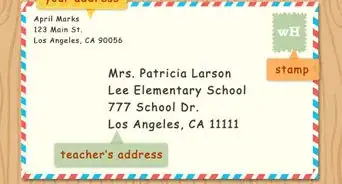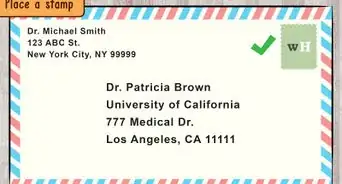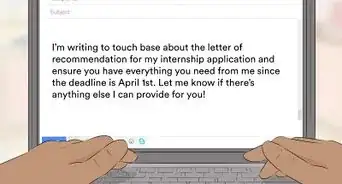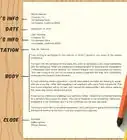This article was co-authored by wikiHow staff writer, Christopher M. Osborne, PhD. Christopher Osborne has been a wikiHow Content Creator since 2015. He is also a historian who holds a PhD from The University of Notre Dame and has taught at universities in and around Pittsburgh, PA. His scholarly publications and presentations focus on his research interests in early American history, but Chris also enjoys the challenges and rewards of writing wikiHow articles on a wide range of subjects.
This article has been viewed 92,953 times.
Learn more...
Serving in the military can be stressful and lonely, so most service members love getting mail from loved ones and strangers alike. If you want to write a letter to an anonymous service member, maintain a positive, uplifting tone, write generally about yourself, thank them for their sacrifice, and consider adding some artwork! Work with a recognized organization to make sure your letter makes it to a random service member. If you’re sending your letter to a particular soldier, make sure you follow the specific mailing guidelines provided by the U.S. Postal Service (or the postal service where you live).
Steps
Writing an Uplifting Letter to a Soldier
-
1Encourage kids (especially) to write by hand and include pictures. Whether it’s from an adult or a child, a handwritten letter always feels more heartfelt and personalized—just make sure the writing is legible! Including artwork is also a great idea, especially when it’s hard to find a lot to write about to a stranger.
- Encourage kids to draw pictures of happy scenes from home, like playing in the park on a sunny day. Discourage drawings that depict fighting, like airplanes shooting at tanks.
- It’s okay to include artwork if you’re an adult as well! Alternatively, send a photo of a beautiful sunset or something similar (but not including you or anyone else in it).
-
2Use a general, positive salutation, especially to an unknown soldier. If you’re writing a letter to a friend or loved one, you can of course use a typical, personalized salutation. For a letter written to an anonymous soldier, though, try something like “Dear Hero,” or “Dear Brave Patriot.” This gives your letter an uplifting tone right from the start.[1]
- In contrast, “Dear Sir or Madam,” is too formal, while “Dear Soldier,” is better but still a bit too generic.
Advertisement -
3Express your thanks for their service. It’s hard to know what to write to a stranger, and sometimes even to someone you know. When writing to a soldier, it’s always a good idea to start by showing your appreciation for the sacrifices they are making.[2]
- It’s fine to simply write, “Thank you so much for your service.”
- Or, try something like, “I am so thankful for you and all the other soldiers who are sacrificing to keep me safe and free.”
- If you're having trouble coming up with the right words for someone you know, consider writing about how proud you are, and how proud other loved ones (by name) are.
-
4Write about yourself in broad details for an anonymous soldier. Especially when you’re writing to an unknown military member, you have to assume that it will be a one-way conversation (that is to say, don’t expect a reply). Spend a few lines letting them know general information about you and your life.[3]
- For instance, a child might write, “My name is Joe. I am in fourth grade. I like spelling class and recess, but not math. I have a little sister named Rose.”
- An adult might write: "I'm Ellen. I'm a CPA in Omaha, and my father served in the Marines in Vietnam."
- Don’t get too personal—provide the same generic information you might give to any stranger. This is particularly true for children writing letters.
-
5Avoid mentioning death, killing, or politically-charged topics to a stranger. Your goal, especially when writing to an anonymous soldier, is to remain kind and uplifting throughout. Don’t ask questions or make assumptions about what they do, or comment on whether you feel like the situation they’ve been put in is right or wrong.[4]
- For example, don’t write something like, “I’m sure it must be very difficult to have to take lives in order to protect our nation,” or, “I really wish our President hadn’t sent you halfway around the world for no good reason.”
- Leave politics completely to the side, and limit your discussion of religion as well. It’s generally okay to write that you’re praying for their safety, though.
- If you know the person, you may be able to discuss touchy issues in broad terms and in ways that you know won't cause distress.
-
6Provide an adult’s contact info if you wish, but don’t expect a reply. It's perfectly fine to send a one-time letter to a random soldier, with no intention of ever hearing back from them. However, if you’re interested in having them write you back, write something like: "If you'd like to write me back, you can write me at ... or email me at ...".[5]
- Never assume that they’ll write you back, though. They may be in a situation that makes it impossible for them to do so, or they may simply feel uncomfortable doing so.
- Kids shouldn’t send their own contact information. They can, with permission, provide an address or email for a parent or their school, however.
- If you know the person, it's never a bad idea to write down your mailing and email addresses. It's possible they may have lost them.
-
7Add a closing sign-off and your first (and maybe last) name. After you’ve offered your thanks, written a little about yourself, and perhaps included a drawing, close up the letter with a simple “Yours Truly” or “Sincerely.” Provide your first name and, if you're comfortable doing so, your last name.[6]
- Unless given permission to do so by a parent, teacher, or other responsible adult, children shouldn't provide their last names.
- You can personalize the closing (with "Love," or something similar) if you know the person.
Sending a Letter to a Random Soldier
-
1Search online for an organization that sends letters to soldiers. There are several organizations that collect batches of letters written for anonymous soldiers and ship them to deployments at home and abroad. Identify and work through one of these organizations if you want to send a letter without having a specific soldier in mind.
- U.S.-based groups include Operation Gratitude and A Million Thanks, among several others.
- Depending on where you live, the group should be either government-affiliated or a reputable charity—check out their ratings on sites like Charity Navigator.
- The U.S. Postal Service (and likely other postal services around the world) will not deliver individual letters addressed to “Any Soldier” (or similar). You must identify specific recipients if you’re sending letters on your own.[7]
-
2Follow the group’s specific guidelines for writing letters. The organization you choose to work with will give you some basic rules and requirements for writing letters. They all require the content to be positive and uplifting, and use screeners to remove letters that are too negative or controversial.[8]
- Other common requirements include: no excessive discussions of politics or religion; no overly personal or specific identifying or contact information about children; and no glitter or confetti!
-
3Don’t write or mention specific dates, since delivery times vary widely. Several groups ask that you not date the letters at all, since there can be lag times of several weeks before delivery. They want the letters to feel current, not dated, for the soldiers who read them.
- So, instead of writing, “It’s December 28, in the middle of my favorite time of year,” write something more general, like, “It’s wintertime, and I love it when the snow starts falling here.”
- The average delivery time for letters sent to overseas U.S. military members is 1-2 weeks, but this can vary greatly based on numerous factors.
-
4Join with friends and send a packet of letters to the organization. Since organizations like Operation Gratitude ship out letters to soldiers in large batches, it’s a great idea to send the group batches of letters written by friends, family, co-workers, classmates, and so on. Start a letter-writing campaign at your school or workplace, gather up the letters into a big envelope or box, and ship it to the organization’s address for processing.[9]
- Operation Gratitude, for example, provides a U.S. mailing address where you'll send your letters to be screened, processed, and shipped. They ask that you stack up all your letters together in a single envelope or box—don't put them in individual envelopes or staple them together.
-
5Ask about donating to the organization to help pay for postage. These groups are typically charitable organizations that don’t require payment for their services, but they do have to incur shipping costs to send all those letters around the world. The group might ask that you make a small donation to pay for shipping costs—for instance, $2 USD—each time you send a packet of letters.
- Even if the group doesn’t request donations, consider inquiring about making one anyway.
- The U.S. Postal Service delivers all military mail, no matter where it goes around the world, at the same rate as domestic mail. But this cost still adds up when you’re sending boxes full of letters![10]
Mailing a Letter to a Specific Soldier (U.S.)
-
1Use only the USPS to send mail to military members. By law, only the U.S. Postal Service (USPS) can deliver mail to military installations in the U.S. and abroad. Other carriers like UPS and FedEx will not accept envelopes or packages addressed to military addresses.[11]
- You’ll end up saving money using the USPS anyway, since you can send a first class letter to a military base halfway around the world for the same price as a domestic letter. (The USPS charges domestic rates for military mail, regardless of destination.)
-
2Treat the letter like domestic mail, not international mail. In addition to including a standard first-class stamp (if you’re just sending a letter), you should address the envelope as if you are sending it within the U.S. For instance, don’t write “Afghanistan” anywhere on the envelope, even if the soldier you’re sending the letter to is on a base in that country.[12]
- The envelope should be look just like any letter being addressed to someone in the U.S. Your return address should be at the top left, the postage at the top right, and the recipient address in the center.
- Write neatly on the envelope. The USPS prefers that you use all caps.
-
3Address and send the letter via “APO” for Army and Air Force personnel. If you are sending your letter to a service member in the U.S. Air Force or U.S. Army, you'll need to provide their name on Line 1, their Unit (or PSC) number and Box number on Line 2, and "APO" plus "AA," "AE," or "AP" and the ZIP code for their deployment on Line 3. Use the following recipient address format:[13]
- Line 1: JAMES WILSON (rank designation is unnecessary)
- Line 2 (Army): UNIT [number] BOX [number]
- Line 2 (Air Force): PSC [number] BOX [number]
- Line 3: APO AA [+ ZIP code] (use “AA” if they’re stationed in the Americas, “AE” if in Europe, and “AP” if in the Pacific)
- The Unit/PSC number, Box number, and ZIP code will vary based on the service member’s deployment.[14]
-
4Address and send the letter via “FPO” for personnel in the Navy or Marines. If your recipient is in the Navy or Marines, their name goes on address Line 1, their Unit and Box (or Ship and Hull) numbers go on Line 2, and "FPO" plus "AA," "AE," or "AP" and the ZIP code for their deployment goes on Line 3. Use the following format:[15]
- Line 1: JAMES WILSON (rank designation is unnecessary)
- Line 2 (on a base): UNIT [number] BOX [number]
- Line 2 (at sea): SHIP [number] HULL [number]
- Line 3: FPO AA [+ZIP code] (use “AA” if they’re stationed in the Americas, “AE” if in Europe, and “AP” if in the Pacific)
- Unit and Box (or Ship and Hull) numbers and ZIP codes vary based on the person’s deployment location and status.[16]
Community Q&A
-
QuestionDo I have to be eligible to write to a soldier?
 Community AnswerNot at all! Soldiers have served our country for many years so that we stay safe. You can show them thanks by doing something special like write a letter.
Community AnswerNot at all! Soldiers have served our country for many years so that we stay safe. You can show them thanks by doing something special like write a letter. -
QuestionHow to begin writing to an older military person?
 CMOsborneCommunity AnswerLike the groups that send letters along to active duty personnel, there are organizations that send letters to anonymous veterans. Search online for reputable groups (check their ratings on sites like Charity Navigator).
CMOsborneCommunity AnswerLike the groups that send letters along to active duty personnel, there are organizations that send letters to anonymous veterans. Search online for reputable groups (check their ratings on sites like Charity Navigator). -
QuestionHow to address a letter to a brigade commander
 CMOsborneCommunity AnswerNo matter the person's rank, the address formatting is the same. In fact, it's fine to exclude the person's rank altogether.
CMOsborneCommunity AnswerNo matter the person's rank, the address formatting is the same. In fact, it's fine to exclude the person's rank altogether.
Warnings
- If you're writing to an anonymous soldier, your letter will be screened by the organization you've chosen to send it along to a military installation. They will reject letters that are deemed too negative, insensitive, or contentious (politically, religiously, etc.).⧼thumbs_response⧽
References
- ↑ https://www.operationgratitude.com/express-your-thanks/write-letters/
- ↑ https://soldiersangels.org/how-to-write-your-first-letter/
- ↑ https://www.veteransunited.com/network/support-our-troops-write-a-letter/
- ↑ https://www.veteransunited.com/network/support-our-troops-write-a-letter/
- ↑ https://www.operationgratitude.com/express-your-thanks/write-letters/
- ↑ https://www.operationgratitude.com/express-your-thanks/write-letters/
- ↑ https://www.aafes.com/Images/doingbusiness/MilitaryMailGuide.pdf
- ↑ https://www.osotamerica.org/comfort-and-care-package-program/card-and-letter-guidelines/
- ↑ https://www.operationgratitude.com/express-your-thanks/write-letters/
- ↑ https://www.usps.com/ship/apo-fpo-dpo.htm
- ↑ https://www.aafes.com/Images/doingbusiness/MilitaryMailGuide.pdf
- ↑ https://www.usps.com/ship/apo-fpo-dpo.htm
- ↑ https://www.usps.com/ship/apo-fpo-dpo.htm
- ↑ https://www.aafes.com/Images/doingbusiness/MilitaryMailGuide.pdf
- ↑ https://www.usps.com/ship/apo-fpo-dpo.htm
- ↑ https://www.aafes.com/Images/doingbusiness/MilitaryMailGuide.pdf

